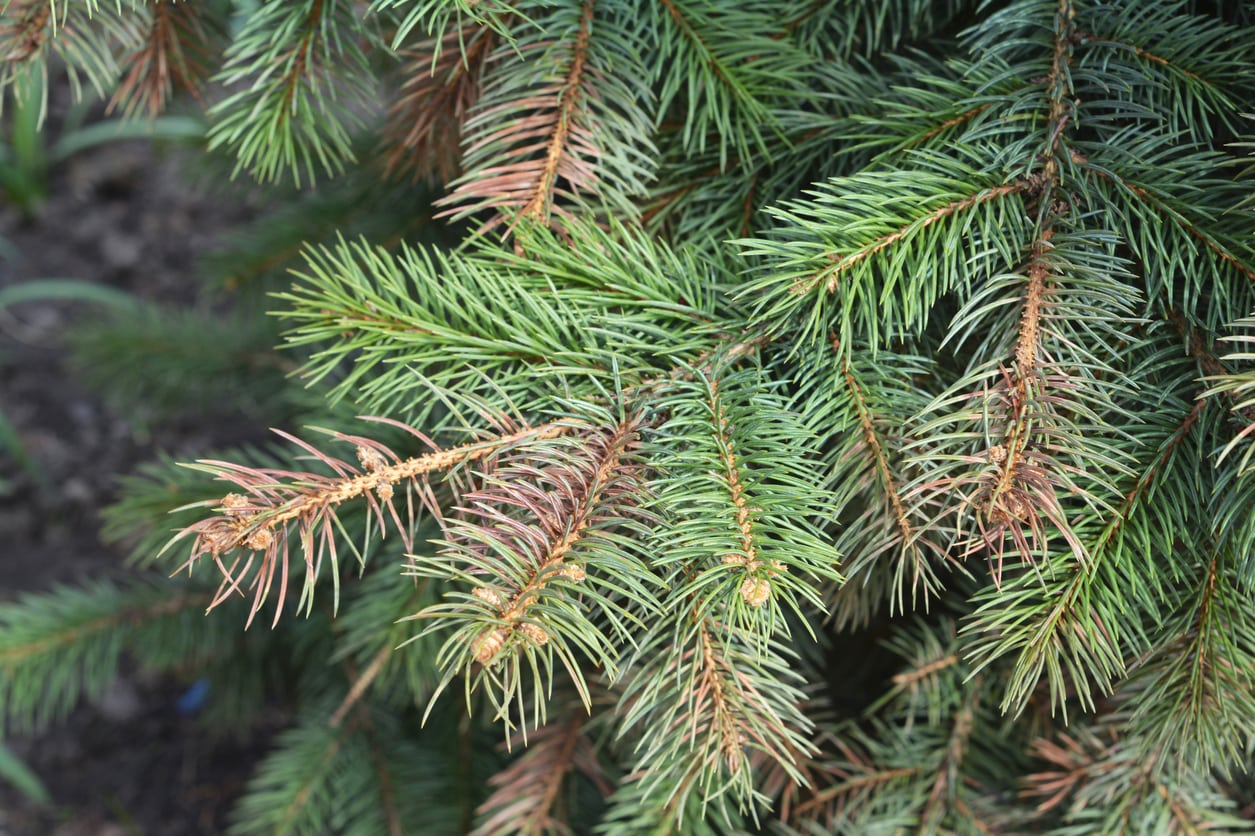[ad_1]
Sometimes conifer trees will certainly be looking healthy and balanced and also environment-friendly and afterwards the following point you recognize the needles are transforming shade. The formerly healthy and balanced tree is currently curtained in tarnished, brownish conifer needles. Why are the needles transforming shade? Can anything be done to deal with browning conifer needles?
Help, My Tree’s Needles are Changing Color!
There are countless factors for tarnished needles. Needles transforming shade might be the outcome of ecological problems, condition or pests.
An usual wrongdoer is winter season drying out. Conifers take place with their needles throughout the winter season, which leads to water loss. Typically, it’s absolutely nothing the tree can not manage, yet often throughout the late winter season to very early springtime when the origin system is still iced up, cozy, completely dry winds worsen water loss. This leads to needles that are transforming shade.
Normally, when winter season damages is responsible for tarnished needles, the base of the needles and also a few other needles will certainly continue to be environment-friendly. In this instance, the damages is normally small and also the tree will certainly press and also recuperate out brand-new development. Much less frequently, the damages is extreme and also branch suggestions or whole branches might be shed.
In the future, to avoid browning conifer needles because of winter season drying out, select trees that are sturdy to your location, plant in well-draining dirt and also in a location safeguarded from winds. When the dirt is not iced up, be certain to water young trees on a regular basis in the loss and also winter season. Mulch around the conifers to stop deep cold, making certain to maintain the compost concerning 6 inches (15centimeters.) far from the trunk of the tree.
In some situations, conifers changing color in autumn is typical as they dropped older needles instead of brand-new.
Additional Reason for Needles Turning Color
Another factor for brownish conifer needles might be the fungal condition Rhizosphaera kalkhoffii, likewise calledRhizosphaera needlecast It impacts spruce trees expanding outside their indigenous area and also begins on the internal and also reduced development. Needlecast is most usual on Colorado blue spruce, yet it does contaminate all spruces.
Needles at the suggestions of the tree continue to be environment-friendly while older needles near the trunk ended up being tarnished. As the condition proceeds, the contaminated needles transform brownish to purple and also advance up with the tree. The tarnished needles loss of in the center of summer season, leaving the tree looking slim and also barren.
As with various other fungal conditions, social techniques can stop the condition. Water just at the base of the tree and also prevent obtaining the needles damp. Use a 3-inch (7.5 centimeters.) layer of compost around the base of the tree. Extreme infections can be treated with a fungicide. Splash the tree in the springtime and afterwards repeat 14-21days later on. If the infection is extreme, a 3rd therapy might be required.
Another fungal condition, Lirula needle curse, is most common inwhite spruce There are no reliable fungicide controls for this condition. To handle it, eliminate contaminated trees, disinfect devices, control weeds and also plant trees with ample spacing to enable great air flow.
Spruce needle corrosion is an additional fungal condition which, as its name recommends, affects just spruce trees. The suggestions of the branches transform yellow and also, in late summer season, light orange to white forecasts show up on contaminated needles that launch grainy orange spores. Contaminated needles decrease in very early loss. Trim unhealthy shoots in late springtime, eliminate drastically contaminated trees and also treat with a fungicide according to the supplier’s directions.
Insect Infestation Browning Conifer Needles
Insects might likewise be creating needles to transform shades. Pine needle range (Chionaspis pinifoliae) feeding reasons needles to after that brownish and also yellow. Significantly plagued trees have couple of needles and also branch dieback, and also might at some point pass away completely.
Biological control of range entails using the twice-stabbed girl beetle or parasitical wasps. While these can regulate the scale infestation, these useful killers are frequently exterminated by various other chemicals. Using gardening oil sprays combined with insecticidal soap or pesticides is a reliable control.
The finest approach to remove the range is using spider sprays that require to be splashed a couple of times at 7-day periods starting in mid-spring and also mid-summer. Systemic pesticides are likewise reliable and also need to be splashed in June and also once again in August.
The spruce crawler mite is harmful to the health and wellness of conifers. Invasions of spider mites cause yellow to reddish-brown needles, come with by silk discovered in between the needles. These bugs are trendy climate bugs and also are most usual in the springtime and also loss. A miticide is advised to deal with the problem. Spray in the very early to mid-May and also once again in very early September according to the supplier’s directions.
Lastly, hill want beetles might be the source of tarnished needles. These beetles lay their eggs under the bark layer and also in doing so leave a fungi that impacts the tree’s capability to uptake water and also nutrients. Initially, the tree continues to be environment-friendly yet within a couple of weeks, the tree is passing away and also in a year all the needles will certainly be red.
This pest has actually annihilated excellent stands of evergreen and also is a significant danger to woodlands. In woodland monitoring, both splashing of chemicals and also shedding and also reducing of trees have actually been utilized to regulate the spread and also attempt of the want beetle.
[ad_2]

